Victorian Indian Mutiny Central India medal Dvr J Meade Royal Artillery Fr Essex
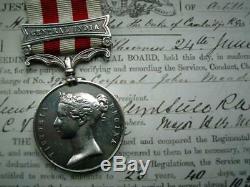
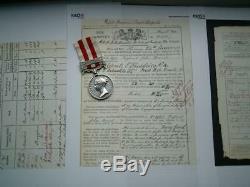

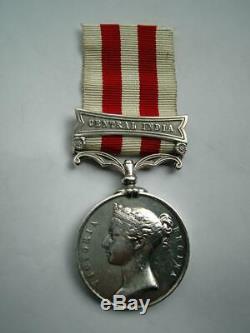

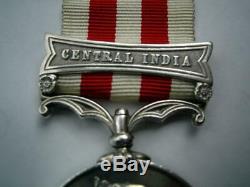
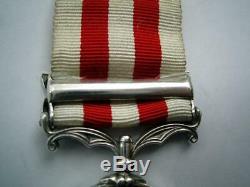

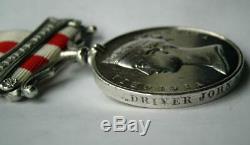
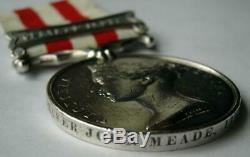
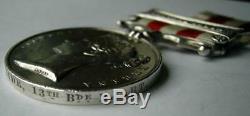


Indian Mutiny 1857-59 medal with Central India Clasp, Official impressed name and Regiment, Driver John Meade, 13th Bde. , some minor contact marks and minimal edge rim bruises , few light marks and scratches if any, design still good, IMO nearly very fine, short silk ribbon, see pictures for condition He attested for the Royal Artillery 3977 Gunner & Driver in 1855, He served for over 10 years in India hence earning Indian Mutiny medal with Central India clasp as stated in service record and medal roll, promoted Bombardier 1867, corporal 1874 discharged after 23 years service in 1878 aged 44. After Discharge, intended address St Helliers, Jersey, Channel Islands.
, some service history and medal roll extract included. Victorian Indian Mutiny Central India medal Dvr J Meade Royal Artillery Fr Essex. Indian Mutiny medal 1857-59 - Central India clasp Driver John Meade 13th Bde RA Indian Mutiny 1857-59 medal with Central India Clasp, Official impressed name and Regiment, Driver John Meade, 13th Bde.
, some minor contact marks and minimal edge rim bruises , few light marks and scratches if any, design still good, IMO nearly very fine, short silk ribbon, see pictures for condition He was born 1834 in Epping, Essex and attested aged 21 for the Royal Artillery 3977 Gunner & Driver in May 1855, He served for over 10 years in India hence earning Indian Mutiny medal with Central India clasp as stated in service record and medal roll, promoted Bombardier 1867, Corporal 1874 discharged after 23 years service in 1878 aged 44. After discharge, his intended address St Helliers, Jersey, Channel Islands.His record is signed by himself with correct spelling " Meade", same as medal and on roll, sometimes others spell his name Mead on paperwork. Central India Campaign was one of the last series of actions in the Indian Mutiny. A small British and Indian Army (from the Bombay Presidency) overcame a disunited collection of states in a single rapid campaign, although determined rebels continued a guerrilla campaign until the spring of 1859.
Indian Mutiny Medal with Central India clasp was awarded for service in Central India January - June 1858, to all those who served under Major-General Sir Hugh Rose in actions against Jhansi, Kalpi, and Gwalior. Also awarded to those who served with Major-General Roberts in the Rajputana Field Force and Major-General Whitlock of the Madras Column, between January and June 1858. The area known to the British at the time as Central India is now occupied by parts of Madhya Pradesh and Rajasthan states. A large part of it was included in the region of Bundelkhand named after its former Bundela rulers.In 1857, it was administered as the Central India Agency and consisted of six large and almost 150 small states, nominally ruled by Maratha or Mogul princes, but actually controlled to a greater or lesser degree by Residents or Commissioners appointed by the Honourable East India Company. Opposition to British control centred on the state of Jhansi, where the Rani Lakshmibai, widow of the last Maratha prince, opposed the British annexation of the state under the notorious doctrine of lapse. Jhansi and Lalitpur districts are now in the state of Uttar Pradesh. The loyalty of the Indian soldiers (Sepoys) of the East India Company's Bengal army had been under increasing strain over the previous decade, and on 10 May 1857, the Sepoys at Meerhut, north of Delhi, broke into open rebellion.
News of this outbreak spread rapidly, and most other units of the Bengal Army also rebelled. Nine regiments of Bengal Native Infantry and three of cavalry were stationed in Central India. There was also a large Gwalior Contingent , raised largely from Oudh (or Awadh) and similar in organisation to the irregular units of the Bengal Army, but in the service of the Maharajah Jayajirao Scinda of Gwalior, who remained allied to the British. Almost all these units rose up against their officers during June and July.
There were very few British units to oppose them, and Central India fell entirely out of British control. At Jhansi, British officers, civilians and dependents took shelter in a nearby fort on 5 June. They emerged three days later after being assured of their safety and were immediately murdered by the rebellious sepoys and irregulars. Rani Lakshmibai had no complicity in this act but was nevertheless blamed by the British (the rebels were then the only armed force in the city and no British forces were there to oppose them). Over the next few months, most of the former Company regiments marched to take part in the Siege of Delhi, where they were eventually defeated.
The Gwalior Contingent remained largely inactive until October, when they were led to defeat at Cawnpore by Tantya Tope. These defeats deprived the rebels of a substantial body of trained and experienced troops, and made the subsequent British campaign easier.Meanwhile, most of the now independent princes began raising levies and warring with each other, or demanding ransoms from each other on threat of force. The Nawab of Banda, who induced several units of Sepoys to join his service on the promise of loot, appears to have been particularly rapacious. One Mogul prince, Firuz Shah, attempted to lead an army into the Bombay Presidency to the south, but was defeated by a small force under the acting Commissioner for Central India, Sir Henry Durand.
Durand then overawed the Holkar Tukojirao II (the ruler of Indore in southern Central India), into surrender. Most of the rebel leaders now surrendered or went into hiding, but Tatya Tope remained in the field. Aided by monsoon rains which delayed his pursuers, Tatya continued to dodge around Central India. Other leaders joined him, among them Rao Sahib, Man Singh, and Firuz Shah (who had been fighting in Rohikhand).
Eventually in April 1859, Tatya Tope was betrayed by Man Singh, and hanged. Indian historians criticise the conduct of the Indian Princes, most of whom were self-interested or effete, and the lack of leadership among the sepoys. In the East India Company's Army, no Indian soldier could attain a rank greater than that equivalent to a subaltern or senior warrant officer.
Most of the Sepoys' officers were elderly men who had attained their rank through seniority while seeing little action and receiving no training as leaders. The rebellion therefore depended on charismatic leaders such as Tatya Tope and Rani Lakshmi Bai, who nevertheless were regarded with jealousy and animosity by many other Princes.
In many cases, the defenders of cities and fortresses fought well at first but were demoralised when relieving forces were defeated, and then abandoned easily defended positions without fighting. By contrast, Durand, Rose, and their principal subordinates had acted quickly and decisively. Many of their forces came from the Bombay Army, which was not disaffected to the same degree as the Bengal Army. The item "Victorian Indian Mutiny Central India medal Dvr J Meade Royal Artillery Fr Essex" is in sale since Sunday, March 29, 2020. This item is in the category "Collectables\Militaria\19th Century (1800-1899)\Medals/ Ribbons".
The seller is "theonlineauctionsale" and is located in England. This item can be shipped worldwide.
- Issued/ Not-Issued: Issued
- Service: Army
- Era: 1816-1913
- Type: Medals & Ribbons
- Country/Region of Manufacture: United Kingdom
- Country/ Organization: Great Britain
- Conflict: Indian Mutiny 1857-58

